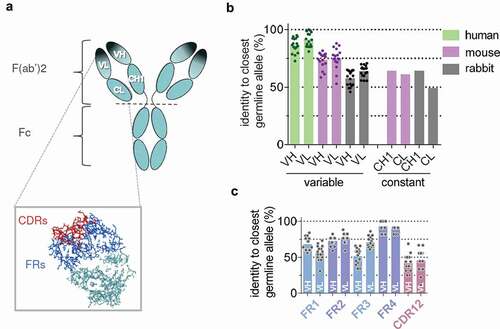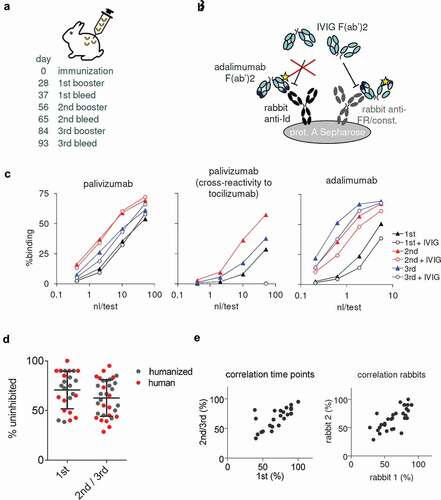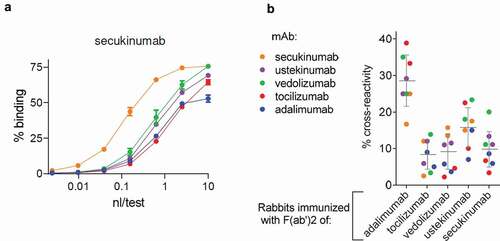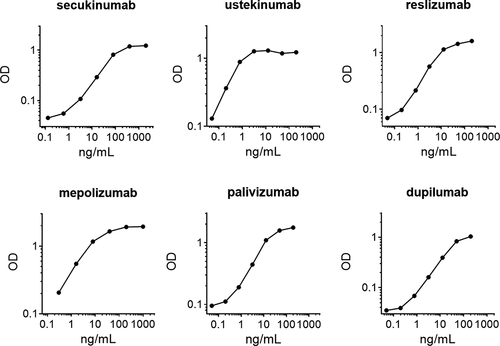Figures & data
Figure 1. Anatomy of therapeutic monoclonal antibodies (tmAb). (a) Structure of an IgG antibody with variable domains (VL, VH) and constant domains (CL, CH1) in the F(ab’)2 region indicated. Dark shade indicates the antigen binding region or ‘paratope’, which largely coincides with the idiotype. Inset shows complementarity-determining regions (CDRs) in red and framework regions (FRs) in blue. CDRs make up the largest part of the paratope. (b) Homology of human(ized) tmAbs with closest germline allele for rabbit, mouse, and human per domain (n = 17; see materials and methods for details). (c) Homology of tmAb variable domains with rabbit for framework regions (FR1-4) and combined CDR1 and CDR2 regions.

Figure 2. Cross-reactivity of polyclonal rabbit anti-tmAb antibodies to polyclonal human antibodies. (a) Immunization scheme. (b) Assay for evaluating rabbit antibody responses: rabbit antibodies are captured onto protein A Sepharose beads and biotinylated tmAb F(ab’)2 is added to detect anti-tmAb antibodies. If IVIG F(ab’)2 is also added, binding of anti-framework and anti-constant domain antibodies, but not anti-idiotype antibodies will be inhibited. (c) Examples of binding curves for rabbit serum upon immunization with a tmAb F(ab’)2, drawn 9 d after a booster. Left panel: palivizumab; middle panel: cross-reactivity to tocilizumab. Notice that IVIG F(ab’)2 completely inhibits the cross-reactive binding; right panel: adalimumab. (d) Percentages of rabbit antibody response not inhibited by IVIG (Fab’)2 (i.e., response in presence of inhibitor relative to response without) after the 1st or 2nd/3rd booster (n = 17 human(ized) tmAbs, 2 rabbits/mAb). Bars represent mean and SD. (e) Correlation between 1st and 2nd/3rd booster (left panel) and rabbit 1 and rabbit 2 (right panel); Pearson r = 0.73, p < .0001, and r = 0.74, p < .0001, respectively.

Figure 3. Cross-reactivity of polyclonal rabbit anti-tmAb antibodies to other tmAbs. (a) Exemplar binding curves for rabbit serum upon immunization with a tmAb F(ab’)2 (secukinumab), drawn 9 d after final booster to secukinumab and four other tmAbs (ustekinumab, vedolizumab, tocillizumab, and adalimumab). (b) Overview of cross-reactivities for rabbits immunized with five different tmAbs (2 rabbits/tmAb), tested against all five tmAbs as in (a). Bars represent mean and SD.

Figure 4. Enrichment of antigen-specific B cells. Gating strategy for single cell sort. Lymphocytes isolated from a rabbit immunized with secukinumab were defined based on FSC and SSC, subsequent exclusion of doublets and gating on either IgG+ B cells (red) or enriched for secukinumab-specific IgG+ B cells (blue).

Table 1. Monoclonal anti-idiotype antibodies obtained from immunized rabbits.

